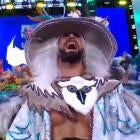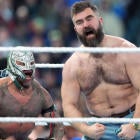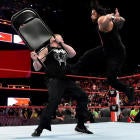To try and best explain the impact Bruno Sammartino had on professional wrestling would be difficult by today's measures, largely because there are simply no easy modern comparisons.
Sammartino, a giant of the sports entertainment industry long before the term was coined, died Wednesday at the age of 82. He was WWE's biggest and most recognizable star for nearly two decades until the launch of Hulkamania and the company's national expansion through the creation of WrestleMania.
But even to fans outside the walls of the then-WWWF during the height of pro wrestling's territory era, Sammartino was far more than just the biggest name in the northeast thanks to his record 187 sellouts as a main event attraction headlining New York's Madison Square Garden. To many, Sammartino was literally the face of the industry as a whole.
Like those born in the Great Depression, who grew up only knowing Franklin Roosevelt as U.S. president thanks to his record four terms and 12 years in office, Sammartino had a similar effect in wrestling to many who came of age in the decades which followed.
Even during a time when the prestige of territorial wrestling championships still meant something thanks to how little they changed hands compared to today, Sammartino still stands alone for his longevity and consistency as a top draw.
During a 14-year span from 1963 to 1977, Sammartino held the WWWF championship for 11 of those years over a period of two reigns. His first title loss to Ivan Koloff in 1971 snapped a nearly eight-year reign of 2,803 days as champion that still stands as a WWE record. The loss only came, in fact, because Sammartino badly needed a break from the touring demands that came with being champion.
While it's nearly certain that his first title reign will never be bested in any modern wrestling promotion, his second reign of 1,237 days (from 1973 to 1977) is no slouch either, and remains the fourth longest in WWE history and bested only by two of the champions who immediately followed him (Bob Backlund and Hulk Hogan).
There was a reason why Sammartino was so trusted and depended upon by Vince McMahon Sr., the late father of current WWE chairman Vincent K. McMahon, throughout a career that spanned nearly 30 years. For Sammartino, and his many fans, it came down to authenticity. Not only was the stocky and barrel-chested Sammartino a legitimate strongman who once set a world record in the bench press in 1959, his brawling in-ring style was believable because of the truly tough man who was hardly playing a character at all.
Everything from Sammartino's given name to his backstory was true. He survived a life-threatening illness as a young child and fled to the mountains of his native Italy during World War II when Nazi soldiers invaded his village. He also wrestled through a legitimate broken neck to finish out a big-money title feud against Stan Hansen in 1976.
The charismatic Sammartino, an Italian immigrant who settled in Pittsburgh, certainly drew well in Italian-American communities on the east coast. But his true drawing power superseded nationalities because how well he connected with paying customers who could easily identify with his working-class exterior.
Outside of the ring, Sammartino also practiced what his character preached in terms of honesty, integrity and standing up for what he believed in. He sued WWF in the early 1980s for unpaid back wages. As part of the settlement, he returned as an announcer -- and occasional wrestler -- but willingly cut ties with the company in 1988 after it fired his son David.
Sammartino's post-WWE run also saw him stand firm as an outspoken critic of McMahon regarding topics such as steroid abuse, undiagnosed head trauma and the raunchy "Attitude Era" of the 1990s that he felt was wrong within the business he loved.
Yet despite the division between the two sides, Sammartino's estranged relationship with WWE came to an end in 2013 when Triple H played a key role in convincing Sammartino to accept an induction to the WWE Hall of Fame.
This wasn't the prodigal son returning home. Instead, it was the most successful promotion the genre has ever known mending enough fences in order to properly recognize its most important superstar from an era where the foundation was built for the transformation from professional wrestling to sports entertainment.
In some ways it was only fitting that Sammartino, appropriately nicknamed "The Living Legend," was front and center as his in-ring and broadcasting career came to an end with WWE in the 1980s for such a handoff to Hogan, WrestleMania, the Rock 'n' Wrestling Connection and the era we know today.
The recent celebration of the late Andre the Giant through the release of HBO's documentary reminded fans just how unique and irreplaceable he was as the last singular attraction of a bygone wrestling era. Hopefully the passing of Sammartino will have a similar effect at reminding those too young to have seen what a true world champion should be.





















